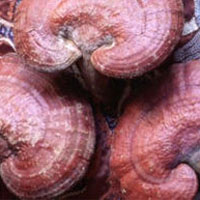Gluten Free
What does following a gluten-free diet mean? That you're embarking on an easy diet with a wide range of health-promoting effects. Instead of dwelling on what you’re giving up, consider that you’re going to enjoy a whole new world of delicious food options to meet your special dietary needs. You’ll be eating seasonally, choosing more fresh fruits and vegetables, focusing on meats, seafood, poultry, legumes, lentils, corn, and rice, and discovering fascinating ancient grains such as quinoa, amaranth, and millet. You’ll be able to eat potatoes, eggs, most cheeses, even chocolate (!)—and enjoy them without guilt because you’ll be taking good care of your body. In fact, you’ll probably end up eating—and feeling—better than ever!
Visit this page for more information about living Gluten Free
---
We carry a large variety of gluten free items, the brands listed below represent just some of the offerings we carry















More Diets
Reishi
 © Steven Foster
© Steven FosterHow It Works
Reishi contains several major constituents, including sterols, coumarin, mannitol, polysaccharides, and triterpenoids called ganoderic acids. Ganoderic acids may lower blood pressure as well as decrease LDL (“bad”) cholesterol. These specific triterpenoids also help reduce blood platelets from sticking together—an important factor in lowering the risk for coronary artery disease. While human research has been reported that demonstrates some efficacy for the herb in treating altitude sickness and chronic hepatitis B, these uses still need to be confirmed in well-designed human trials.5 Animal studies and some very preliminary trials in humans suggest reishi may have some beneficial action in people with diabetes mellitus and cancer.6 Two controlled clinical trials have investigated the effects of reishi on high blood pressure in humans and both found it could lower blood pressure significantly compared to a placebo or controls.7, 8 The people with hypertension in the second study had previously not responded to medications, though these were continued during the study.
How to Use It
Reishi can be taken either as 1.5–9 grams per day of the crude dried mushroom, 1–1.5 grams per day in powdered form, 1 ml per day of tincture, or as a tea.9
Copyright © 2025 TraceGains, Inc. All rights reserved.
Learn more about TraceGains, the company.
The information presented by TraceGains is for informational purposes only. It is based on scientific studies (human, animal, or in vitro), clinical experience, or traditional usage as cited in each article. The results reported may not necessarily occur in all individuals. Self-treatment is not recommended for life-threatening conditions that require medical treatment under a doctor's care. For many of the conditions discussed, treatment with prescription or over the counter medication is also available. Consult your doctor, practitioner, and/or pharmacist for any health problem and before using any supplements or before making any changes in prescribed medications. Information expires December 2025.











